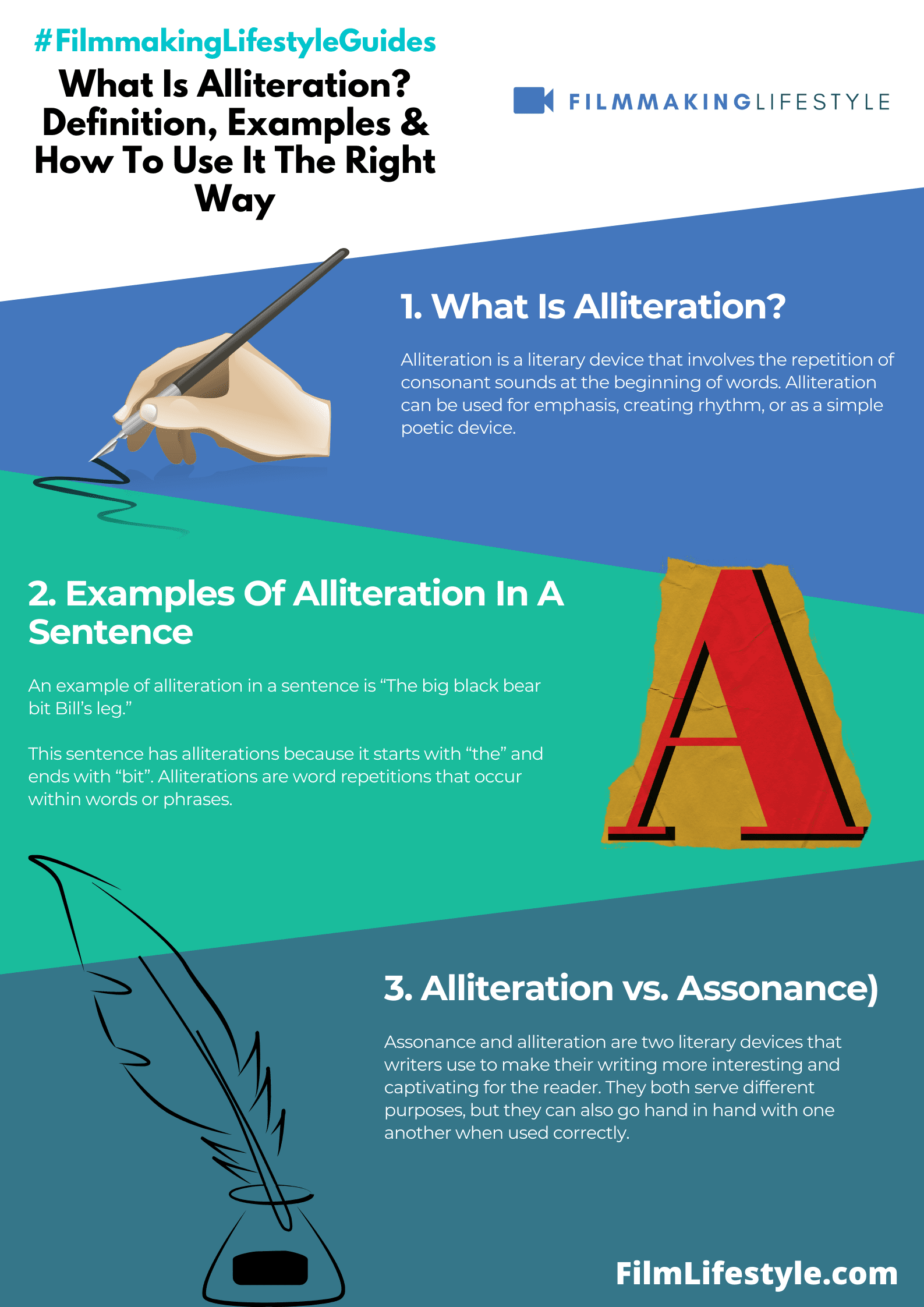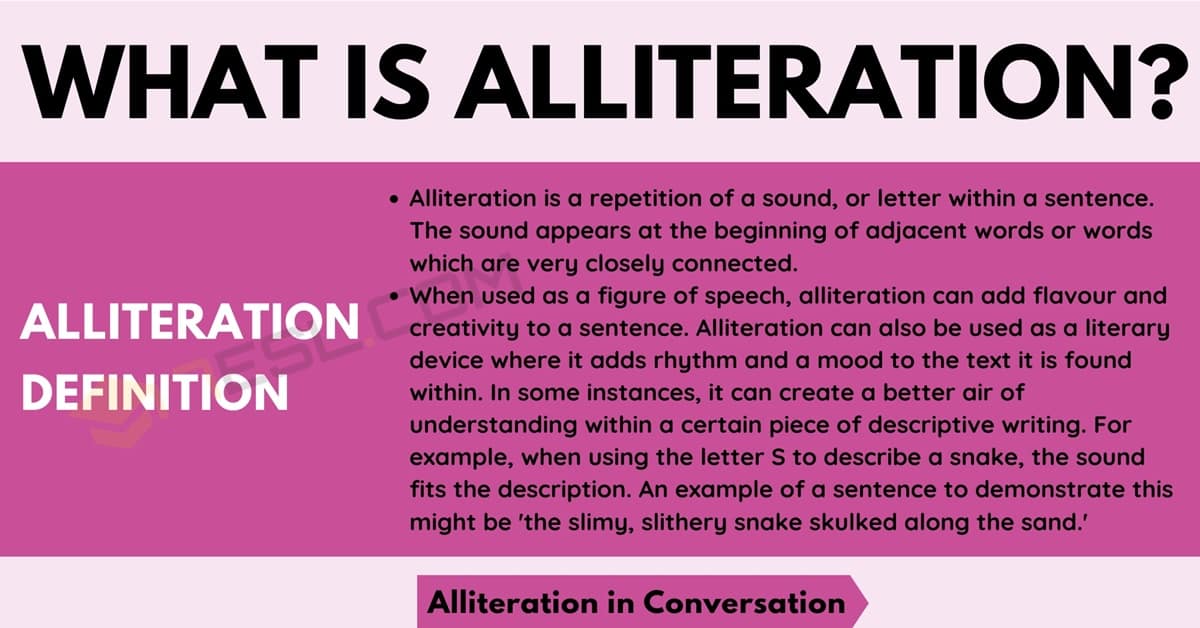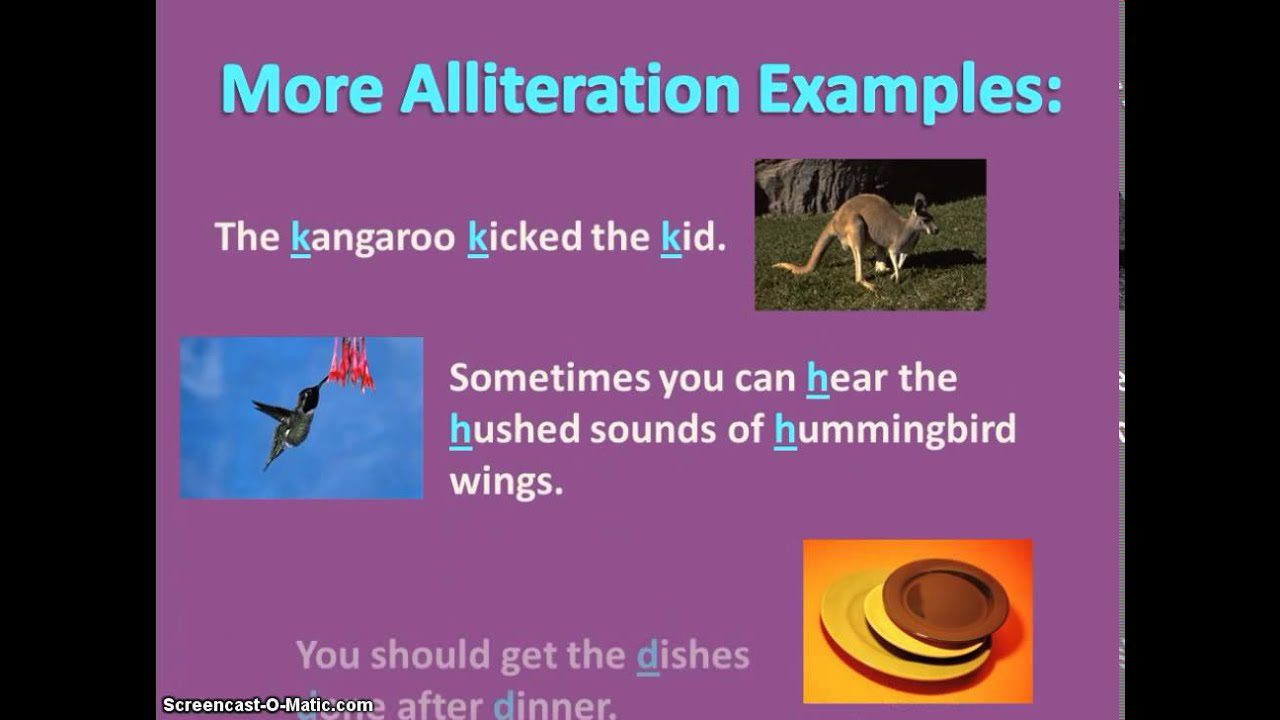What is Alliteration? Alliteration refers to the repeated occurrence of the same basic consonant sound, or several similar-sounding phonetic units, in consecutive or closely related words, even though pronounced differently.
As a source of aesthetic value, alliterations are called forward alliterations or forward speech.
In poetry, alliterations are used to mark the beginning of a poem; in prose, alliterations mark important structural turns or shifts.
WHAT IS ALLITERATION
What Is Alliteration?
Alliteration is the repetition of consonant sounds at the beginning of words, often in poetry.
Alliteration can be used to create a rhythm and sound effect or for emphasis.
The word alliteration itself is an example of this as it starts with two “a”s followed by three “l”s and another “a”.
Alliteration is a literary device that’s as fun to say as it is to use, peppering phrases with a pleasing poetic punch.
It’s the repetition of consonant sounds at the beginning of words that are close together in text or speech.
What Is Alliteration?
Alliteration is at the core of our creative narrative strategies.
It’s the sonic glue that gives dialogue a persuasive rhythm and flair.
In the realm of film and scriptwriting, we often rely on this technique to craft memorable lines that resonate with audiences.
Alliteration’s power lies in creating pleasing auditory patterns that help with retention, making certain phrases from films like V for Vendetta unforgettable.
When we sift through the elements of alliteration, we identify its purpose and potential impact.
Scripts that Use alliteration effectively can convey characters’ personalities and themes within a story.
Consider Peter Parker from Spider-Man, where his character is associated with punchy alliterative phrases that mirror the quick and vibrant world he inhabits.
Alliteration isn’t just a tool for scriptwriters though.
In marketing materials, including movie titles and taglines, we leverage alliterative appeal to grab attention and make the promotional content stick.
Think of titles such as Dirty Dancing or King Kong – the repeated initial consonant sounds create a catchy recall factor that benefits the film’s marketability.
To optimize the use of alliteration in our projects, we break down its functionalities:
- Accentuate emotion,
- Emphasize key points,
- Enhance linguistic rhythm.
We pay careful attention to the sounds that resonate most with our target demographic.
For instance, softer sounds might be used in a romantic movie title to evoke a gentle or tender feel.
In contrast, harder sounds could be preferred for an action-packed or dramatic scene to amplify intensity.
By digging deeper into the subtleties of alliteration, we refine our ability to engage and captivate an audience.
Whether it be through scripts, movie titles, or promotional efforts, alliteration serves as a versatile and powerful element in our arsenal of creative techniques.
Functions Of Alliteration
Alliteration serves many functions within language and artistic expression.
It’s not just a decorative element but a tool that can significantly enhance the communication of ideas.
Strengthening Connections Between Words
Alliteration ties concepts together with a satisfying auditory pattern.
This technique helps words to resonate collectively and to be remembered as a unit.
Creating Rhythm And Musicality
In both poetry and prose, alliteration contributes to the overall rhythm.
It introduces a musical quality that can make passages more engaging and enjoyable to read.
Evoking Emotional Responses
Sound plays a crucial role in influencing emotion.
Alliteration can amplify feelings associated with words, making emotions more intense or subtle depending on the context.
Impacting Narrative Pace
By strategically using alliteration, we can control the pace at which a story unfolds.
Rapid alliteration quickens the tempo, while slower patterns can create a more reflective or somber mood.
Enhancing Brand Recall In Marketing
Business names, taglines, and slogans often leverage alliteration:
- Catchy Campaigns – Think of brands like Coca-Cola or Best Buy,
- Memorable Messages – Slogans such as “PayPal Puts People First”,
- Product Popularity – Names like Dunkin’ Donuts stand out.
Reinforcing Film Titles And Character Names
Alliteration in titles like Crazy Rich Asians or character names such as Peter Parker makes them more appealing and memorable.
It draws attention and helps build a strong brand around a film.
By mastering the fine art of alliteration, we’re able to wield it effectively across various creative fields.
Whether crafting dialogue for a gripping scene or outlining the unique selling points of a product, alliteration is an ace up our sleeve.
Examples Of Alliteration
Discovering alliteration isn’t just for poetry or literature – it permeates many aspects of the creative arts, including film and marketing.
It’s a tool that heightens interest, ensuring that titles and phrases are not only memorable but also immediately impactful.
Let’s look at some iconic films where alliteration adds to the allure and intrigue of the cinematic experience.
V for Vendetta harnesses the power of this poetic device within both the title and the protagonist’s dialogue.
Then there’s Peter Pan, where the repetitive ‘P’ leads us into a world of fantasy and adventure.
In marketing, alliteration serves as an anchor in consumers’ minds.
Brands like Best Buy and Coca-Cola have exploited alliteration to the fullest, etching themselves into our collective memory.
Similarly, tongue twisters in advertisements often use alliteration – catchy and sometimes comedic, they make the brand stick.
Historic speeches often utilized alliteration to underscore critical points.
Consider Martin Luther King Jr.
’s “I Have a Dream” speech.
Phrases like “darkness cannot drive out darkness” and “justice rolls down like waters” demonstrate the rousing effect alliteration can have.
To recognize alliteration, keep an ear out for:
- Repetition of initial consonant sounds in close proximity,
- Usage in film titles, character names, and dialogue,
- Presence in powerful slogans and brand names,
- Appearance in everyday idioms and phrases like “sweet smell of success” or “bigger and better”.
It’s clear that alliteration isn’t just for dramatic effect in the written word.

It has traveled through time, from ancient texts to modern-day media, proving its enduring appeal across various communication forms.
Effects Of Alliteration In Literature
Alliteration wields a unique influence in literature that extends well beyond adding a tuneful quality to phrases and sentences.
It binds concepts and emphasizes themes, making it a powerful literary device for authors and poets.
The strategic use of alliteration shapes the texture and sound of a narrative.
In iconic works such as The Great Gatsby, alliteration adds a lyrical resonance that draws readers into the world crafted by the author.
Our appreciation for the subtleties of language is often heightened by the presence of alliteration.
It can transform ordinary writing into a more evocative and memorable experience.
Literature brims with examples that demonstrate the varied effects alliteration has:
- Crafting memorable lines that linger in the mind,
- Establishing a mood or atmosphere,
- Mirroring the action or emotion in the narrative.
In poetry, alliteration serves an even more pivotal role.
It often operates in tandem with other literary devices such as assonance and consonance to create rich layers of sound and meaning.
Our engagement with text is profoundly influenced by the rhythm and flow that alliteration helps establish.
The cadence generated by repeating initial consonant sounds can mirror the ebb and flow of action or emotion, making literary works more dynamic.
Alliteration in literature does more than just tickle the ear – it’s a tool that enchants the mind.
Through skillful repetition of sounds, writers can guide readers to see, hear, and feel the worlds they create in more vivid color and texture.
What Is Alliteration – Wrap Up
We’ve explored the intricate dance of alliteration and its profound impact on our linguistic landscape.
It’s clear that this stylistic device does more than tickle the ear; it wields the power to shape our perception of texts and leaves a lasting imprint on our memories.
Whether in the subtle hum of a poet’s verse or the catchy jingle of a commercial, alliteration captivates and carries us through the waves of language.
Let’s continue to appreciate and harness this tool, not just as readers and listeners but as creators who craft the symphony of words that move the world.
Frequently Asked Questions
What Is The Main Function Of Alliteration In Language?
Alliteration serves to create rhythm, enhance musicality, evoke emotions, and strengthen connections between words, influencing how language is both received and perceived by the listener or reader.
How Does Alliteration Impact The Pace Of A Narrative?
Alliteration can either accelerate the tempo of a narrative through rapid repetition or slow it down to draw attention to specific phrases or ideas, thus impacting the narrative’s pace.
Why Is Alliteration Important In Branding And Marketing?
In branding, alliteration enhances recall by making brand names, slogans, and taglines more memorable and engaging, thereby increasing brand recognition and consumer recall.
How Does Alliteration Influence Literature?
Alliteration binds concepts and emphasizes themes within literature, enriching the text’s sound and texture, and transforms ordinary writing into a more evocative and memorable experience.
What Role Does Alliteration Play In Poetry?
Alliteration works in tandem with other literary devices in poetry to create deep layers of sound and meaning, enriching the poem’s auditory experience and enhancing its emotive power.








